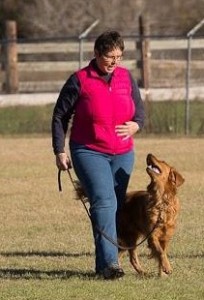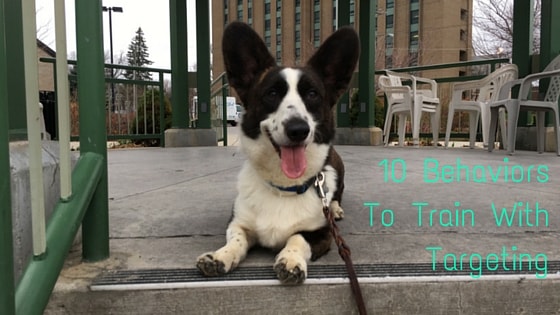Chat Time Interview With Karen Deeds, CDBC Of Canine Connection

Karen with Cassidy (Golden Retriever) and Rock (Labrador Retriever); image via Karen Deeds, www.deedscanineconnection.com
Who Is Karen Deeds?
I do Facebook interviews with animal trainers, behaviourists and other professionals. I met up with Karen Deeds CDBC to chat about how she approaches aggression in dogs.
Karen Deeds became a Certified Dog Behavior Consultant, with the International Association of Animal Behavior Consultants, in October of 2013 and has taught at seminars and conferences in Texas, as well as other parts of the U.S. She is sought after for her expertise in training and behavior modification. In 2010, Karen received the Association of Pet Dog Trainers award for “Community Educator of the Year.” In 2013 she received the Dog Scouts of America “Good Scout Award,” recognizing her for her service to Dog Scouts.
You can find her –
Website – http://www.deedscanineconnection.com
Facebook – https://www.facebook.com/pages/CanineConnection/479935655150?pnref=lhc
My Interview With Karen About Dog Aggression
Lisa White: Thank you so much for joining us, Karen.
Karen Deeds: Thank you for the invite!
LW: How did you get into training and behavior?
KD: It was in the early 90s when I was working with my dog on an out of sight down stay when I went behind the building and was met with an assailant. My dog came to my rescue after hearing me scream.
The next time he saw a person that was similar to the person who had assaulted me, he was aggressive. That was before I really knew what I was doing, but I brought the guy (who was a bather at the groom shop where I had taken him to be groomed), some hotdogs, and I started tossing my dog, Shoney, some hotdogs every time the kid came outside and he saw him.
Simple classical conditioning! I had taken Psych classes in junior college so I was familiar with some things!
I then started asking Shoney to perform various obedience tasks like Sit and Down in the presence of the trigger. Luckily I had a lot of good things going on with my dog in that he was a very stable boy and this was a single traumatic incident.
That is when I first realized there was a difference between training and behavior! At that time, most trainers were teaching more traditional methods that they used in competition even though that is not really what most pet dog owners needed.
LW: Indeed. So what methods do you use?
KD: I use positive reinforcement and utilize a variety of different protocols. I love to get a dog thinking so I love to free shape. It builds confidence by giving the dog the ability to make choices. I will use some luring, targeting, and of course shaping for basic skills with pet dog owners.
LW: Word is that you are well known for dealing with aggression. Can you tell us more about that?
KD: Yes, I do deal with a lot of aggression and reactivity. I guess it all started with Shoney. There was just such a need around here and I started to attend seminars, read books, and do ANYTHING I could to get more educated.
I also work with a lot of rescue organizations to help them assess dogs and that has led me to be pretty black and white about some of these cases.
LW: What do you mean by “black and white about some cases?”
KD: I think it is extremely important to understand the limitations of each case. I use a 15 point variable system to help determine what option is best for a client and the dog as well as how those variables influence the outcome.
It isn’t always about the dog – the owners and their environment play vital roles in the decision and my recommendations.
LW: What is that 15 point variable system?
KD: I’ll briefly outline them:
- Severity – I typically use the Ian Dunbar scale because it is simple for the owners to understand. The higher the number the worse the prognosis. There is also the location of the bite that I consider.
- Predictability – if the trigger is easy to predict it does make things easier to set up for behavior modification. Unpredictability is difficult, but a lot of times that unpredictability is only in the eye of the owner!
- Controllability – Being able to contain the dog for management purposes is vital as well. You can’t ALWAYS be working the program so the dog needs to be able to be contained safely. Whether it be in a crate, on a tether, in a muzzle, behind a baby gate or whatever.
- Previous training is a HUGE factor and it has become even more of a variable now that I see more dogs that have previously been trained with electronic collars or traditional ‘dominance’ methods. It diminishes trust and can often create a dog that can’t think for itself or has had the communication skills punished out of them.
- Trainability – A dog that is easy to motivate is easier to train. The lack of motivation can equal lack of desire to change behavior. Food is usually fastest, but play can be as strong or stronger for some dogs.
- Socialness – There are simply some dogs that do not have a desire to be social; either with strangers or other dogs. Unfortunately so many pet owner think their dog ‘needs’ to be social and all they really want is to be that little hermit dog that sleeps all day safely in the living room!
- Children – This starts to get into the ‘people’ and environment factors which are, IMO, some of the most important. If there are children in the environment and they are a trigger then there needs to be huge consideration for what option is appropriate. There are only four options: Management (which usually fails at some point); Management and training and b-mod; Rehome; or Euthanize.
- Size of dog must be considered not only because a dog over 40 pounds can be harder to manage and contain, but perception from the public is also different. Not many people care if they get nipped by a Maltese (no offense to Maltese people!) but if it is a bigger dog then they do!
- Breed of dog – unfortunately it can matter! Because I do a lot of aggression people think I see Pit Bulls, Rottweilers and Dobermans, but my highest case loads are herding dogs, dogs under 25 pounds, and sporting breeds. Sometimes they appear to come in waves!
- Finances play a part too. An owner needs to be able to afford the medical work ups, the management systems, the training tools, and the help from a qualified trainer or behavior consultant or behaviorist. There is also the real possibility of litigation as well as medical costs if damage is done to a victim.
- Time – It is a valuable commodity and many people simply don’t have enough time to put into managing the dog let alone modifying its behavior and training them.
- Commitment – This can often be a lifelong commitment. There isn’t a quick fix and they must be prepared to go the distance.
- Compliance – Sometimes I know many of us in the field feel like marriage counselors! It is vital that everyone be on the same page in the household so that no one is undermining their success. Much like a kid that learns to go to mom when dad says no, it is confusing for the dog and creates unpredictability.
- Cognitive Dissonance – this has been something I really didn’t think would be an issue, but I have had several cases lately that one partner simply didn’t want to believe that their dog was afraid and not dominant! If they don’t buy into the science, I can’t help them!
- Duration – If the problem has been going on for a long time then the likelihood of changing it is diminished. The Matching Law is in play at that point. And some variables will outweigh the others. I have worked with clients with children in the home with a dog with a level 4 bite that I would never have worked with in a different home.
I find that the ‘people factors’ are the most vital. That is why I have had good luck with dog/dog issues doing board & trains. I can lay the foundation and then follow up with the clients.
LW: So if the owner doesn’t comply with your recommendations, then failure is the result.
KD: To a certain extent. It does depend on the severity at that point. In most cases enough improvement can be made that the owner can manage.
LW: At what point would/should one give up on an aggressive dog?
KD: I usually recommend that clients set a specific time before they reassess. 30-45-90 days, if at that point they simply can’t continue with the program, or there isn’t sufficient change, or there is another incident them we may have to come to another conclusion and different option.
LW: I find a lot of people/trainers seem to judge owners for their inability not to commit time to working with their aggressive dog. What are your feelings on this?
KD: I am not in their shoes. I will never judge them (at least not in front of them!), but seriously, I HAVE been there myself. I remember having to euthanize a dog I was fostering way back in the 80s because she had almost killed another one of my dogs and had then turned on my 3 year old son. I have been in the vet office holding many hands when they said goodbye to their family pet. I also have emails and get phone calls thanking me for allowing them to make such a decision that has freed up their lives and reduced stress in the household.
LW: It is a very stressful situation; you are on pins and needles all the time.
KD: Yes it is stressful for EVERYONE. Especially inter-housemate aggression or households with children.
LW: Unfortunately, time is up and we have to end this interview. Thank you so very much, Karen, for taking the time to chat with us.
KD: A very special thank you for considering me worthy of an interview!
Thank You
We’d like to extend a big thank you to Karen for letting us share this interview on The Modern Dog Trainer blog.
Get Dog Training Business Tips!
Receive valuable dog training business tips and resources every week! Subscribe to The Modern Dog Trainer now by submitting your name and email below.
[mc4wp_form]






